Input interpretation

phenol
Chemical names and formulas
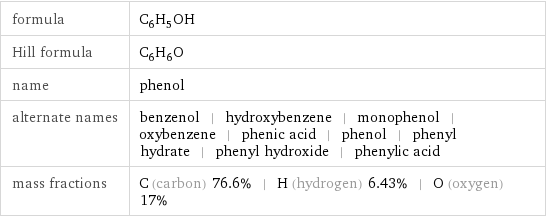
formula | C_6H_5OH Hill formula | C_6H_6O name | phenol alternate names | benzenol | hydroxybenzene | monophenol | oxybenzene | phenic acid | phenol | phenyl hydrate | phenyl hydroxide | phenylic acid mass fractions | C (carbon) 76.6% | H (hydrogen) 6.43% | O (oxygen) 17%
Lewis structure
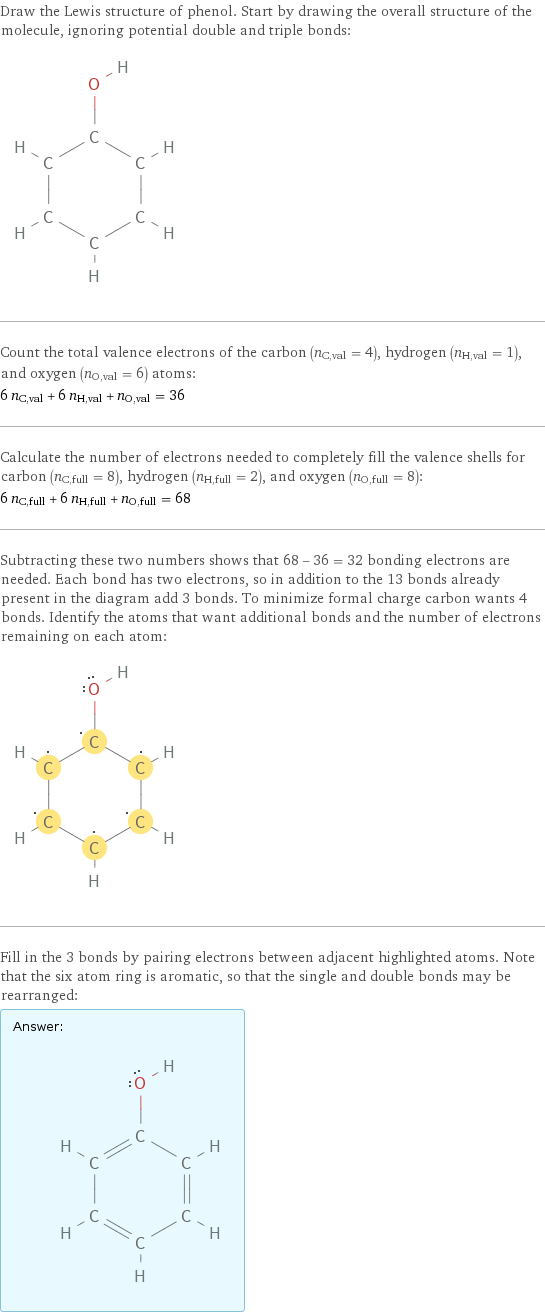
Draw the Lewis structure of phenol. Start by drawing the overall structure of the molecule, ignoring potential double and triple bonds: Count the total valence electrons of the carbon (n_C, val = 4), hydrogen (n_H, val = 1), and oxygen (n_O, val = 6) atoms: 6 n_C, val + 6 n_H, val + n_O, val = 36 Calculate the number of electrons needed to completely fill the valence shells for carbon (n_C, full = 8), hydrogen (n_H, full = 2), and oxygen (n_O, full = 8): 6 n_C, full + 6 n_H, full + n_O, full = 68 Subtracting these two numbers shows that 68 - 36 = 32 bonding electrons are needed. Each bond has two electrons, so in addition to the 13 bonds already present in the diagram add 3 bonds. To minimize formal charge carbon wants 4 bonds. Identify the atoms that want additional bonds and the number of electrons remaining on each atom: Fill in the 3 bonds by pairing electrons between adjacent highlighted atoms. Note that the six atom ring is aromatic, so that the single and double bonds may be rearranged: Answer: | |
3D structure
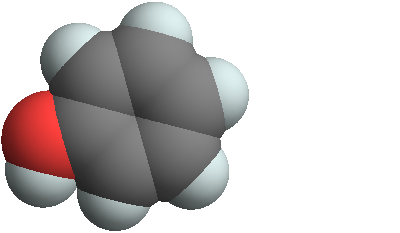
3D structure
Basic properties
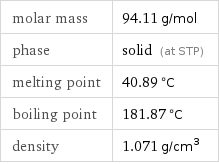
molar mass | 94.11 g/mol phase | solid (at STP) melting point | 40.89 °C boiling point | 181.87 °C density | 1.071 g/cm^3
Units

Hydrophobicity and permeability properties

predicted LogP hydrophobicity | 1.39 experimental LogS | 0 predicted LogS | -0.31
Basic drug properties

approval status | experimental | small molecule drug categories | local anti-infective agent | disinfectant | sclerosing solution
Solid properties (at STP)
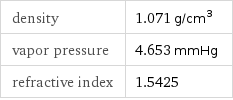
density | 1.071 g/cm^3 vapor pressure | 4.653 mmHg refractive index | 1.5425
Units

Thermodynamic properties

specific heat capacity c_p | solid | 13.537 J/(g K) molar heat capacity c_p | solid | 1274 J/(mol K) specific heat of formation Δ_fH° | gas | -1.024 kJ/g | solid | -1.754 kJ/g molar heat of formation Δ_fH° | gas | -96.4 kJ/mol | solid | -165.1 kJ/mol molar heat of vaporization | 57.8 kJ/mol | specific heat of vaporization | 0.614 kJ/g | molar heat of combustion | 3053.5 kJ/mol | specific heat of combustion | 32.445 kJ/g | molar heat of fusion | 11.51 kJ/mol | specific heat of fusion | 0.1223 kJ/g | critical temperature | 694 K | critical pressure | 6.13 MPa | (at STP)
Chemical identifiers

CAS number | 108-95-2 Beilstein number | 969616 PubChem CID number | 996 PubChem SID number | 3446 SMILES identifier | C1=CC=C(C=C1)O InChI identifier | InChI=1/C6H6O/c7-6-4-2-1-3-5-6/h1-5, 7H InChI key | ISWSIDIOOBJBQZ-UHFFFAOYAI RTECS number | SJ3325000 MDL number | MFCD00002143
NFPA label

NFPA label
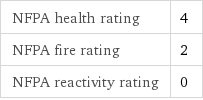
NFPA health rating | 4 NFPA fire rating | 2 NFPA reactivity rating | 0
Safety properties
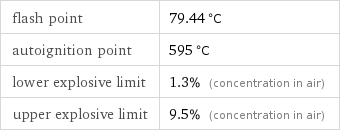
flash point | 79.44 °C autoignition point | 595 °C lower explosive limit | 1.3% (concentration in air) upper explosive limit | 9.5% (concentration in air)

DOT hazard class | 6.1 DOT numbers | 1671 | 2312 | 2821
Toxicity properties

lethal dosage | 317 mg/kg (oral dose for rats) short-term exposure limit | 38 mg/m^3 threshold limit value | 5 ppmv

probable lethal dose for man | 30 mL (milliliters) long-term exposure limit | 19 mg/m^3 (over 8 hours) RTECS classes | agricultural chemical and pesticide | tumorigen | mutagen | reproductive effector | human data | primary irritant